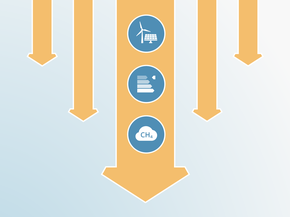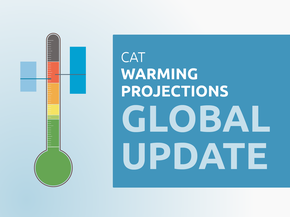Targets
Targets Overview
In February 2025, Canada submitted its 2035 NDC to the UNFCCC, committing to reduce its emissions by 45–50% below 2005 levels by 2035. For more information, please see the 2035 NDC tab. However, this new submission did not increase ambition for 2030, with Canada maintaining its existing target, set in 2021, to cut emissions by at least 40–45% below 2005 levels by 2030 (incl. LULUCF).
The inclusion of LULUCF in Canada‘s NDC, along with uncertainties in the data for this sector, makes it difficult to clearly quantify the reduction target for the rest of the economy. For example, the most recent government emissions projections estimate up to 41 MtCO2e of removals in 2030, but this figure has varied from 27 to 45 MtCO2e in recent years. In its 2030 Emissions Reduction Plan, the federal government also left the door open to the possibility of using internationally transferred mitigation outcomes (ITMOs) to help meet its emissions reduction targets (Environment and Climate Change Canada, 2022).
Canada passed the Canadian Net-Zero Emissions Accountability Act in June 2021, which enshrines its 2050 net zero target—as well as its 2030 target—into law. Canada last updated its long-term strategy in November 2022.
| CANADA - Main climate targets |
|---|
| 2030 NDC target | |||
|---|---|---|---|
| Formulation of target in NDC | At least 40-45% below 2005 levels by 2030 | ||
| Absolute emissions level in 2030 excl. LULUCF |
Level of emissions to be achieved at home (domestic target component) 425-483 MtCO2e [20-30% below 1990] [34-42% below 2010] Level of emissions to be achieved in total through domestic action and use market credits (full NDC target) 426-484 MtCO2e [20-30% below 1990] [34-42% below 2010] |
||
| Status | Updated NDC submitted on 12 July 2021; the 2035 NDC submission did not increase the 2030 target’s level of ambition | ||
| Net zero target | |||
|---|---|---|---|
| Formulation of target | Net zero GHG emissions by 2050 | ||
| Absolute emissions level in 2050 excl. LULUCF | 100 MtCO2e | ||
| Status | Updated LTS submitted on 31 October 2022 | ||
NDC Updates
In July 2021, Canada submitted its updated NDC to the UNFCCC, in which it strengthened its emissions reduction target from a 30% reduction below 2005 levels by 2030 to at least 40-45% (Government of Canada, 2021c). The inclusion of the reference to ‘at least’ suggests that Canada may exceed this target. We calculate that this target equates to an emissions level in 2030 of 425-483 MtCO2e once the contribution from its land sector has been excluded, or 36-44% below 2005 levels.
The focus of Canada’s emissions reduction target is on cutting emissions domestically; however, in its NDC submission, the government reconfirms that it will continue to explore buying international carbon credits to meet its emissions reduction targets. The federal government is working on its policy on international carbon credits (Environment and Climate Change Canada, 2022a). This approach risks shifting responsibility for mitigation abroad—potentially undermining domestic climate action—delaying investment in Canadian solutions, and raising concerns about the integrity and verification of international carbon credits.
| Canada - History of NDC Updates | First NDC (2017) | 2021 NDC update |
|---|---|---|
| 1.5°C Paris Agreement compatible |
|
|
| Stronger target | N/A |
|
| Fixed/absolute target |
|
|
| First NDC (2017) | 2021 NDC update | |
|---|---|---|
| Formulation of target in NDC | Economy-wide target to reduce its greenhouse gas emissions by 30% below 2005 levels by 2030; from 759 MtCO2e in 2005 to 531 MtCO2 in 2030 | At least a 40-45% reduction in GHG emissions compared to 2005 levels. |
| Absolute emissions level in 2030 excl. LULUCF | 539-561 MtCO2e |
Domestic target 425-483 MtCO2e Full target (incl. carbon credits use*) 426-484 MtCO2e |
| 2030 emissions compared to 1990 and 2010 excl. LULUCF |
8–11% below 1990 levels 23–26% below 2010 levels |
Domestic target 20-30% below 1990 34-42% below 2010 levels Full target (incl. carbon credits use*) 20-30% below 1990 34-42% below 2010 levels |
| CAT Rating |
NDC target against modelled domestic pathways** Insufficient NDC target against fair share** Highly insufficient |
NDC target against modelled domestic pathways Almost sufficient NDC target against fair share Insufficient |
| Sector coverage | Economy-wide | Unchanged |
| Separate target for LULUCF | No | Unchanged |
| Gas coverage | All greenhouse gases | Unchanged |
| Target type | Absolute emission reduction below a base year | Unchanged |
* Includes the use of international carbon credits of 0.5 MtCO2e.
** Before September 2021, all CAT ratings were based exclusively on fair share and only assessed a country’s target. We are showing how it would have been rating under our current system for the sake of comparability.
Analysis of earlier NDC developments:
- 12.07. 2021 – Canada submits its updated NDC
- 22.04. 2021 – Canada announces a stronger NDC target
CAT rating of targets
The CAT rates NDC targets against each country’s fair share contribution to global climate change mitigation, considering a range of equity principles including responsibility, capability, and equality. The CAT also rates NDC targets against indicative national emissions from global least-cost emissions pathways (called modelled domestic pathways). For assessing targets against the fair share, we consider both a country’s domestic emission reductions and any emissions it supports abroad through the use of market mechanisms or other ways of support, as relevant.
Canada has indicated that it will use market mechanisms to achieve its target, but has not provided full details on the extent of its use of buying offshore mitigation through internationally transferred mitigation outcomes (ITMOs). Relying on ITMOs to achieve emissions reduction targets risks shifting responsibility for mitigation abroad, potentially undermining domestic climate action and delaying investment in Canadian solutions. There are also concerns about the integrity and verification of international carbon credits.
Canada has specified the amount of international carbon credits it intends to use from the linked cap-and-trade system between Quebec and California, as part of the Western Climate Initiative (WCI). The federal government is accounting for a small amount—0.5 MtCO2e—of international credits from this market in its emissions projections. We have rated Canada’s NDC target both without these credits (i.e. considering only domestic reductions) against domestic pathways, and with the inclusion of credits from the WCI against our fair share metric.
The CAT rates Canada’s domestic target as 'Almost sufficient' when compared to modelled domestic pathways and as 'Insufficient' when compared to its fair share emissions allocation.
The 'Almost sufficient' rating indicates that Canada’s domestic target in 2030 is not yet consistent with the 1.5°C temperature limit but could be, with moderate improvements. If all countries were to follow Canada’s approach, warming could be held below—but not well below—2°C.
We rate Canada’s 2030 target as Insufficient' when compared with its fair share emissions allocation. The 'Insufficient' rating indicates that Canada’s NDC target in 2030 needs substantial improvements to be consistent with its fair share to the global mitigation effort to limit warming to 1.5°C. Canada’s target is at the least stringent end of what would be a fair share of global effort, and is not consistent with the 1.5°C limit, unless other countries make much deeper reductions and comparably greater effort. If all countries were to follow Canada’s approach, warming would reach over 2°C and up to 3°C.
To close the ‘fair share gap’ Canada either needs to begin supporting emission reductions abroad (on top of its domestic reductions, not as a means to reach its emissions reduction targets) or increase its provision of climate finance.

Canada’s international public climate finance contribution is rated 'Highly insufficient'.
In June 2021, Canada announced a doubling of its climate finance commitment from CAD 2.65bn for the period of 2015-2021 to CAD 5.3bn for the period of 2021-2026 (Government of Canada, 2021d). This pledge is being delivered through a mix of grants (40%) and concessional loans (60%). The support covers mitigation, adaptation and loss and damage measures (Government of Canada, 2022b). While this doubling of the country’s climate finance commitment was a positive step, it did not change Canada‘s 'Highly Insufficient' rating as its past contributions (OECD, 2022) have been low compared to its fair share. The CAT weighs absolute contributions the highest amongst the four elements we assess.
Canada remains committed to the collective goal of USD 100bn a year in climate finance for developing countries through 2025. However, the USD 100bn goal on its own is insufficient in the period post-2020.
Canada is making progress on reducing support for fossil fuel development abroad, but a complete phase-out by 2030 looks unlikely.
At COP26, Canada agreed to “end new direct public support for the international unabated fossil fuel energy sector by the end of 2022”, but it kept the door open to allow for exceptions under certain circumstances (Government of Canada, 2022p; UK Government, 2021). In 2022, the federal government published a policy on how it will implement this commitment, although critics have pointed out the guidelines allow for continued support for fossil gas in the power sector and CCUS in the fossil fuel sector (Natural Resources Canada, 2022; Soubry & Cameron, 2024). While Export Development Canada claims to be implementing this ban and plans to not renew unabated fossil investments upon maturity, but foresees this natural turnover to only lead to a 15% reduction in their oil and gas financing by 2030 (Export Development Canada, 2023)
To improve its rating, Canada needs to stop funding fossil fuel overseas completely and strengthen commitments to provide climate finance.
Net Zero target and other long-term targets
Canada passed the Canadian Net-Zero Emissions Accountability Act in June 2021, which enshrined its 2050 net zero target as well as its 2030 target into law (Government of Canada, 2021e). Canada updated its long-term strategy in October 2022. The strategy explores a number of different scenarios capable of achieving net zero emissions in 2050, but none sets a clear pathway for the country to follow nor outlines the policies and measures needed to achieve its net zero target. Reliance on LULUCF and CDR by 2050 could be as high as 45% of Canada’s emissions in 2020 (or 301 MtCO2e). In all scenarios, Canada is still producing and exporting oil and gas in 2050.
For our full analysis of the net zero target, click here.
Further analysis
Latest publications
Stay informed
Subscribe to our newsletter




